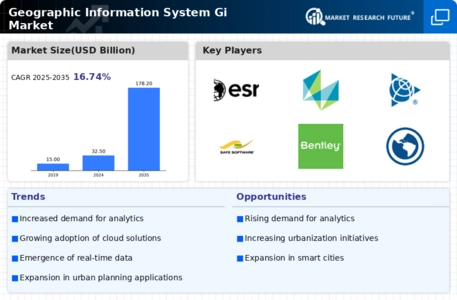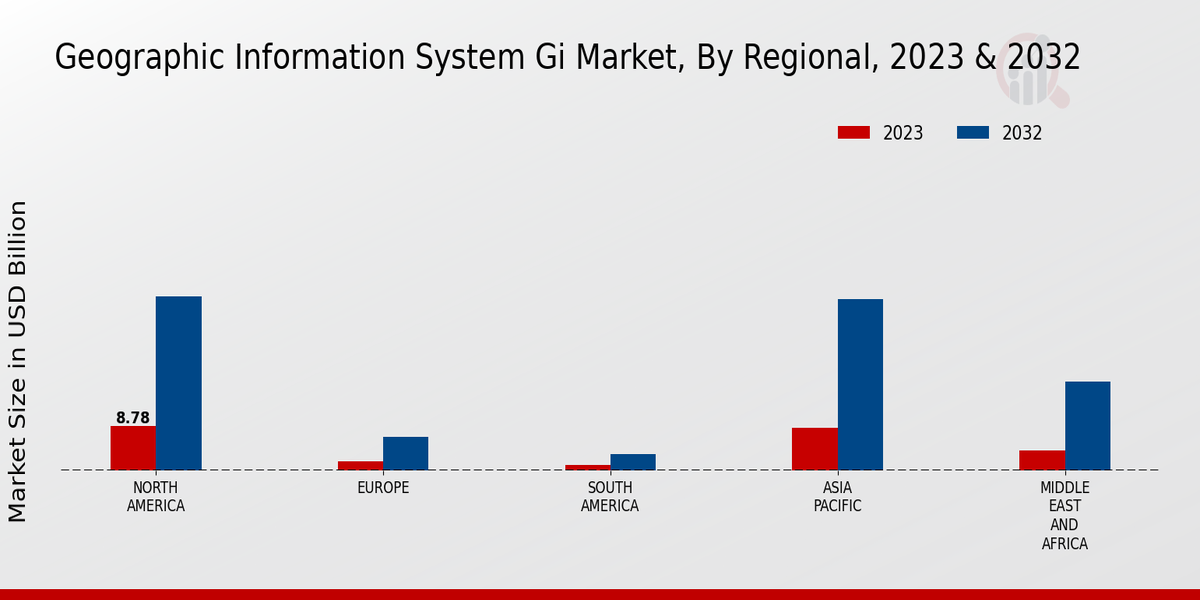Expansion of Smart Cities
The expansion of smart cities significantly impacts the Global Geographic Information System Gi Market Industry. As urban areas evolve into smart cities, the integration of technology and data analytics becomes essential for efficient city management. GIS plays a pivotal role in this transformation by providing real-time data for traffic management, public safety, and resource allocation. The increasing investment in smart city initiatives is expected to drive the GIS market growth, as cities leverage geographic data to enhance livability and sustainability. This trend aligns with the broader global movement towards urban innovation and efficiency.
Market Growth Projections
The Global Geographic Information System Gi Market Industry is poised for remarkable growth, with projections indicating a market value of 32.5 USD Billion in 2024 and an anticipated increase to 178.2 USD Billion by 2035. This growth trajectory suggests a compound annual growth rate (CAGR) of 16.74% from 2025 to 2035. Such figures reflect the increasing reliance on GIS technologies across various sectors, including agriculture, transportation, and urban planning. The ongoing advancements in technology, coupled with rising demand for spatial data, contribute to this optimistic outlook for the GIS market.
Advancements in Technology
Technological advancements play a crucial role in the evolution of the Global Geographic Information System Gi Market Industry. Innovations such as cloud computing, artificial intelligence, and machine learning enhance the capabilities of GIS, allowing for more sophisticated data analysis and visualization. For example, AI algorithms can process vast amounts of geographic data, providing insights that were previously unattainable. This technological evolution is expected to propel the market to a staggering 178.2 USD Billion by 2035, with a CAGR of 16.74% from 2025 to 2035. As organizations increasingly adopt these technologies, the demand for advanced GIS solutions continues to rise.
Growing Environmental Awareness
The growing awareness of environmental issues drives the Global Geographic Information System Gi Market Industry. As climate change and sustainability become pressing global concerns, GIS emerges as a vital tool for environmental monitoring and management. Organizations utilize GIS to analyze land use changes, track deforestation, and assess the impacts of climate change on ecosystems. This heightened focus on environmental sustainability is likely to increase the market's value, as businesses and governments seek to leverage GIS for effective environmental planning. The integration of GIS into environmental strategies reflects a broader commitment to sustainable development.
Increasing Demand for Spatial Data
The Global Geographic Information System Gi Market Industry experiences a surge in demand for spatial data across various sectors, including urban planning, environmental management, and transportation. As cities expand and populations grow, the need for accurate geographic data becomes paramount. For instance, urban planners utilize GIS to optimize land use and infrastructure development, ensuring sustainable growth. This trend is reflected in the projected market value of 32.5 USD Billion in 2024, indicating a robust interest in spatial analytics. The integration of GIS in decision-making processes enhances efficiency and effectiveness, driving further investment in this technology.
Government Initiatives and Investments
Government initiatives and investments significantly influence the Global Geographic Information System Gi Market Industry. Many governments worldwide recognize the importance of GIS in enhancing public services, disaster management, and resource allocation. For instance, national mapping agencies are investing in GIS infrastructure to improve data accessibility and accuracy. In the United States, the Federal Geographic Data Committee promotes the use of GIS for better decision-making in federal agencies. Such initiatives not only foster innovation but also stimulate market growth, as public sector investments often lead to increased adoption of GIS technologies in the private sector.

















